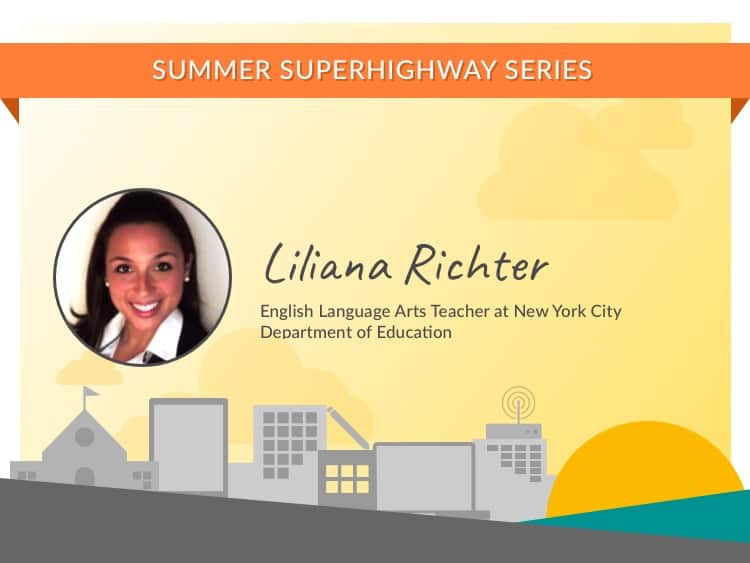Equitable digital access is the foundation for ensuring that teachers can personalize learning and provide students with the educational opportunities they need to be prepared for college and a career. In our latest installment, Liliana Richter, an English Language Arts teacher in New York City schools, inspires us with her commitment to teaching for social justice and her previous experience as a Peace Corps volunteer in El Salvador.
1. Tell us about your experience as an educator in New York. Has technology always been available to you and your students?
I am going into my 8th year teaching in New York City schools. I spent two years at a new Title I charter schools in Staten Island that struggled in many ways but had Smartboards and new MacBooks. I then taught and was a teacher-leader for four years at a progressive, intentionally diverse, reflective, and, well, an incredible charter school in Brooklyn. This school had a lot of resources and spent money wisely. They also had smart boards, laptops, Google Classroom, and all sorts of subscriptions to student online resources. The school I switched to this past year is also intentionally diverse. (Both schools are in rapid-gentrifying areas in close proximity to public housing, and had to fight to try to continue to serve a population representative of the community since they were becoming predominantly wealthy while the community itself remained diverse.) This school also has laptops available and Google Classroom, but not smart boards.
2. Do you think of your students as digital natives? Why or why not?
Absolutely. However, this doesn’t always translate to a more formal, academic setting. For example, my students know a great deal about social media, many can create music digitally, are prolific texters, etc, but have trouble typing on a laptop. Some do not come into 8th grade with the skills to decipher quality sources online. (Although to be fair, many adults, digital natives or not, lack this same skill…) A few of my students type their papers on their phones and copy and paste them into google classroom because they’re so much quicker that way.
3. What kinds of technology do your students use in the classrooms? How comfortable are they using technology as a learning tool?
My 8th graders’ culminating project is a 20-page research paper on a social injustice of their choice. (My entire curriculum is centered around social injustice and how we might play a role in helping our country live up to its ideals.) They collect and analyze research digitally, and receive feedback digitally as well. They search for articles using trusted sources, including Google Scholar, and they reach out to experts on their research topic online.
They don’t need much support by 8th grade–maybe just some support for specific details (like the indentation on works cited page, which can be a little tricky), but generally are very comfortable using laptops by the time they get to 8th grade. This is true even for students who do not have computer access at home.
4. In what ways has technology helped support your role as a teacher? How do you think your experience is different at a charter school?
Technology helps me support all learners in accessing the learning, and in organizing and sharing my curriculum with other teachers. I create slides daily and create a graphic organizer, classroom materials, find images, up-to-date readings etc all online. I can’t imagine my life as a teacher without technology. While it has only happened once or twice in my eight years in NYC schools, the days where there might be a technology issue can be quite anxiety-inducing because I rely on it so heavily.
5. You’ve previously taught outside the United States. Describe your access and experience with technology in non-US schools.
Now, this is interesting to think about…I was a Peace Corps volunteer in El Salvador from 2007-2010. I can divide that experience into two parts–my experience as a youth development Peace Corps Volunteer, and when I competed on their version of Dancing with the Stars in order to get two bridges built in my rural community in which I lived my first two years. Students were lassoed across a dangerous part of a river to get to school during the rainy season.
My first two years I was in a small rural community. The only technology was simple Nokia phones. No one had Internet access in my community, and technology, as I think about it now, was largely non-existent. I disseminated information for the projects I initiated by relying on rumor-mill networks, hand-written signs, announcements at the many churches, or the one school.
The months I was on Dancing with the Stars were of course different. I was getting a message and need to be shared through a television program, and people “voted” via text message. I was on television daily, and after I fractured two vertebrae on live television, the project was funded, and students all got to walk to school sans lasso across a dangerous river.
6. In comparison and in your experience, how has access to reliable technology leveled the playing field for low-income students in New York?
Unfortunately it hasn’t leveled the playing field, and while technology can play a role in ameliorating the situation, it won’t be through laptops and technology as long as we have one of the most segregated school systems in the country, and, well, as long as we are allowed to have such segregated schools. That being said, I believe social media and access to technology (ie #blacklivesmatter) is making more apparent and undeniable the profound inequity that exists and needs righting. I suppose one example of a benefit, is that my students who might not otherwise have been able to access scholarly articles in the past are able to do so through Google Scholar and an email to the author when an institution is trying to charge for access. Armed with knowledge, they will hopefully continue to fight the good fight.
Disclaimer: EducationSuperHighway is a non-partisan non-profit. We do not endorse any specific vendor, political entity, or organization. The views expressed in this series are exclusively those of the person or people being interviewed.




